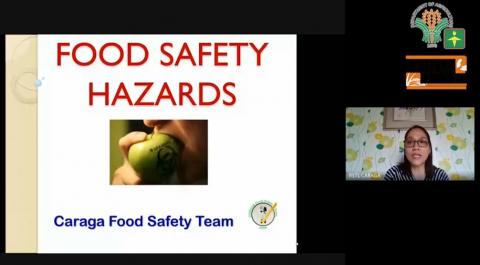Jennifer Dejarme, Sr. Science Research Specialist of the Department of Science and Technology (DOST) Caraga Region delivered her topic about Food Safety Hazards last October 9, 2020 via Google Meet.
LOS ANGELES, Butuan City – Food consumption may be good for your health, but not being too careful could lead to sickness and death. This was learned during the second episode of the i-BIDA nATIn Season 4 webinar series on Food Safety Hazards. This was delivered by Jennifer Dejarme, Sr. Science Research Specialist of the Department of Science and Technology (DOST) Caraga Region last October 9, 2020 via Google Meet.
Dejarme began her presentation by defining what “Hazard” is. She classified it as a substance or agent present in food with the potential to cause an adverse health effect to the consumer. She further qualified what food safety hazards is by saying that this may be a biological, chemical, or physical agent in food, or in the condition in food, with the potential to cause an adverse health effect.
Furthermore, Dejarme gave examples of biological hazards which include bacteria, yeast, mold, viruses, protozoa, parasites, and parasitic worms.
Microorganisms, she said, are either good or bad. Those good or beneficial microorganisms help ferment foods to preserve them and/or create unique flavors and textures. Examples of these are kesong puti, nata de coco, puto, toyo, patis, vinegar, tocino, chorizo, ginamos, bread, beer, wine, yogurt, and kimchi. However, there are also bad microorganisms which are also known as spoilers. They are present in discolored or mushy vegetables, sour milk, bad-smelling meat, and moldy bread.
It was also mentioned that bacteria cause the greatest number of food-borne illnesses. Ninety percent of the agents of contamination are bacteria and only 6% are viruses. Factors affecting bacterial growth are food, acid, time, temperature, oxygen, and moisture.
Dejarme advised not to consume foods exposed for more than two hours in temperatures between 4-63 Celsius. She further said that prevention in consuming contaminated foods is through thorough cooking, proper personal hygiene, and disposal of spoiled food products.

